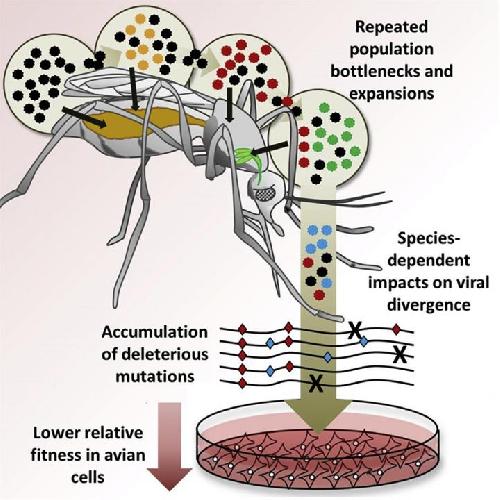A new study on how the West Nile virus evolves in four species of mosquitos shows that viruses accumulate mutations in their insect carriers that reduce how well they reproduce when passed on to a bird host. Viruses carried by one of the tropical species were best able to maintain their reproductive fitness and thus spread. The study, published March 31, 2016 in Cell Host & Microbe, could lead to new strategies for predicting and preparing for future viral outbreaks.
"Arthropod-borne viruses are some of the most difficult and persistent problems in public health. They've been burdening humanity for a very long time and continue to do so today," says senior author Gregory Ebel of Colorado State University. "Our study is significant because we identified one mosquito species that seems to be most important in generating new virus variants. This adds to the body of evidence that different mosquitoes and birds can have very different impacts on RNA virus evolution."
Of all disease-transmitting insects, the mosquito is the greatest menace, spreading malaria, dengue, and yellow fever, which together are responsible for several million deaths and hundreds of millions of cases every year. Currently, mosquito-borne viruses such as West Nile, Chikungunya, and Zika viruses are all in various states of emergence at local or global scales. To predict and prepare for future outbreaks, it's necessary to understand the selective forces that shape virus evolution in different mosquito species and vertebrate hosts.
 This visual abstract depicts how viruses undergo repeated tissue associated bottlenecks during systemic mosquito infection, and the recovery genetic diversity is species dependent. These cycles, along with weak purifying selection, are responsible for the fitness costs associated with mosquito transmission. Credit: Grubaugh et al./Cell Host & Microbe 2016
This visual abstract depicts how viruses undergo repeated tissue associated bottlenecks during systemic mosquito infection, and the recovery genetic diversity is species dependent. These cycles, along with weak purifying selection, are responsible for the fitness costs associated with mosquito transmission. Credit: Grubaugh et al./Cell Host & Microbe 2016
To address this question, Ebel and his team infected four different mosquito species with the West Nile virus and used next-generation sequencing to characterize virus populations within distinct tissues. They found that the genetic diversity of the virus population depended on the mosquito species, with the greatest accumulation of mutations occurring in the southern house mosquito, Culex quinquefasciatus.
However, the viral mutations that accumulated in all four mosquito vectors imposed a fitness trade-off in vertebrate hosts. These mutations reduced the ability of West Nile virus populations to survive in infected chicken skin cells when competing against viruses that did not undergo mosquito transmission. But West Nile virus populations from Culex quinquefasciatus fared better than virus populations from the other three mosquito species.
Taken together, the findings show that Culex quinquefasciatus may be a significant driver of West Nile virus divergence and is more likely to transmit viruses that exhibit greater fitness in avian hosts compared to other mosquito species. This information could be used to help focus ongoing surveillance strategies and outbreak prediction efforts with an eye toward the emergence of new virus genotypes that could alter transmission patterns.
"Based on our work, you could make predictions about what kinds of ecologies might lead to West Nile virus that is more or less fit, and where novel genotypes might come from," Ebel says. "For example, most of the new US West Nile virus genotypes seem to have originated in the southern US. Our data on mosquitoes fit with this because Cx. quinquefasciatus are found in the south, and also seem to be more likely to generate new West Nile virus genotypes compared to more northern species."
The researchers plan to further explore the underlying evolutionary mechanisms at play and determine whether similar findings hold for the Zika virus. "This is important because when outbreaks of arboviruses occur, as is happening with Zika right now, there are tremendous opportunities for the virus to undergo evolutionary change in order to maximize transmission potential," Ebel says. "Notably, this has happened recently with Chikungunya and West Nile virus. It doesn't seem like a stretch to think that it could happen with Zika, too."
source: Cell Press